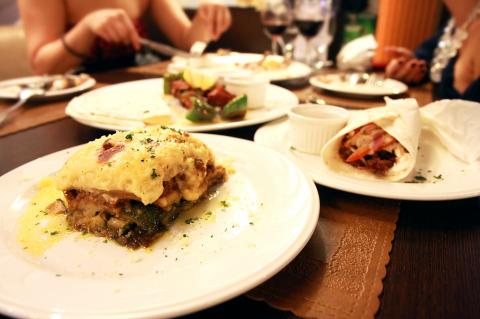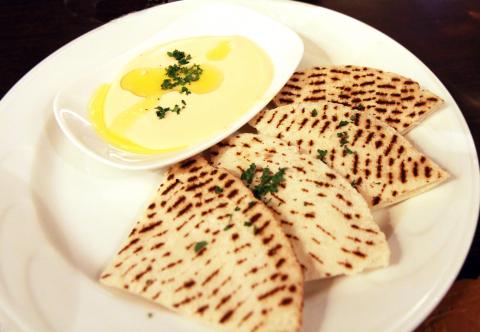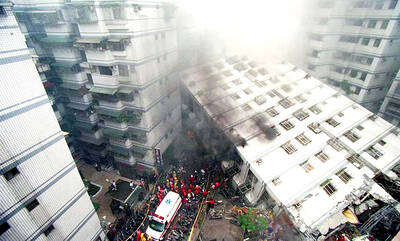Taipei lacks good Mediterranean fare, and the few places that have taken a stab at it have not lived up to the region’s many flavors. So I was skeptical when I heard news of another Greek kitchen opening up. Following my third trip in a month, however, I am convinced that Opa Greek is a bona fide culinary cruise through traditional Greece.
Opa Greek is not trying to be anything it’s not — like a white stucco hut in Santorini, Greece. Besides one mural of the picturesque town looking out over azure seas, you would never know it is a Greek restaurant just by looking at it. The homey dining room leans towards the upscale, with dark and bold furnishings that are offset by bright, maybe a little too bright, lighting.
There is something to be said about western-style service, which was consistent throughout all of my visits. An English language teacher from the US and her Philippino husband run Opa Greek. Her vision sparked interest in the parents of one of her students, and soon, they were all greeting patrons together. Their chef studied gastronomy in Greece under the supervision of an 86-year-old local woman in a 140-year-old restaurant, and those are the recipes that are offered on their bill of fare.

Photo: Olivia Wycech
The menu is extensive, so sharing is encouraged even beyond the appetizers. I suggest sharing some dips so more time can be spent with the rest of the menu. For people that have been coveting proper tzatziki (NT$130), Opa has what you are looking for. And don’t forget to try the htipiti (NT$160), a creamy blend of feta cheese and roasted red peppers that is slightly spicy. A few wedges of pita accompany all the dips. The kalamarakia (NT$220), or calamari, is breaded western style and delicately fried, served with a heap of tzatziki. I regret not ordering the spinach and artichoke fondue (NT$240), as I enviously eyed my neighbors and almost asked for a taste.
There are only three salads on the menu, and you don’t want to confuse them. The horiatiki salad (Greek village summer salad, NT$180 solo, NT$480 to share) is what made Greek salad famous, with big chunks of tomatoes, cucumbers, feta, olives and bell peppers bathed in a red wine and caper infused vinaigrette. Don’t be fooled by the Greek-style salad (NT$180 solo, NT$480 to share), which is more of a tossed salad over mixed greens, topped with a sweet Greek vinaigrette. It’s different, but still very good. Unless salad is your only dish, the solo is sized to share.
Both the greek lentil soup (NT$130) and the kakavla soup (NT$195) will remind you of that soup your mother once made that you can never just get right yourself. They are both light in flavor and density, and while smoky lentils are the main attraction of the lentil soup, the kakavla, also called the Greek fisherman’s stew, comes loaded with a variety of seafood simmered in a saffron-laced broth. Portions are small and not ideal for sharing, but definitely worth sipping.

Photo: Olivia Wycech
Remember just one word when ordering the gyros (NT$160 to NT$220) and the souvlaki (NT$250 to NT$350): lamb. Not only is mutton the meat of choice in Greek cuisine, but it’s also Opa’s specialty. The gyros are stuffed with shavings of soft and succulent lamb, red onions and tomatoes. The souvlaki, meanwhile, is much meatier. Hunks of meat are seasoned, skewered and then grilled with onions and bell peppers. Both are served with tzatziki, pita and honey mustard sauce.
There is a reason that moussaka (NT$250) is considered Greece’s national dish, and if you’ve never had it, Opa is a good place to start. Imagine a piece of lasagna minus the pasta and plus a thick — and I mean thick — layer of rich bechamel sauce that blankets a strata of beef, pork, eggplant and zucchini. The kotopolo lemonato (NT$380) came recommended and was sharp-flavored for being roasted chicken. It’s joined on the plate with feta and potatoes showered with lemon.
The desserts at Opa Greek, which I’ve tried every time I’ve gone to the restaurant, are consistently excellent. The baklava (NT$180) gets my blessing as best dessert. Phyllo pastry, walnuts and lemon honey are layered under a mound of what is perhaps the magic touch — ice cream. Even after being presented with a flaming mango (NT$250), the baklava still won out. But it was close, because triple sec drizzled over mango served on fire with ice cream is essentially a melting pot of what I imagine heaven to taste like.

Photo: Olivia Wycech

Seven hundred job applications. One interview. Marco Mascaro arrived in Taiwan last year with a PhD in engineering physics and years of experience at a European research center. He thought his Gold Card would guarantee him a foothold in Taiwan’s job market. “It’s marketed as if Taiwan really needs you,” the 33-year-old Italian says. “The reality is that companies here don’t really need us.” The Employment Gold Card was designed to fix Taiwan’s labor shortage by offering foreign professionals a combined resident visa and open work permit valid for three years. But for many, like Mascaro, the welcome mat ends at the door. A

Last week gave us the droll little comedy of People’s Republic of China’s (PRC) consul general in Osaka posting a threat on X in response to Japanese Prime Minister Sanae Takaichi saying to the Diet that a Chinese attack on Taiwan may be an “existential threat” to Japan. That would allow Japanese Self Defence Forces to respond militarily. The PRC representative then said that if a “filthy neck sticks itself in uninvited, we will cut it off without a moment’s hesitation. Are you prepared for that?” This was widely, and probably deliberately, construed as a threat to behead Takaichi, though it

If China attacks, will Taiwanese be willing to fight? Analysts of certain types obsess over questions like this, especially military analysts and those with an ax to grind as to whether Taiwan is worth defending, or should be cut loose to appease Beijing. Fellow columnist Michael Turton in “Notes from Central Taiwan: Willing to fight for the homeland” (Nov. 6, page 12) provides a superb analysis of this topic, how it is used and manipulated to political ends and what the underlying data shows. The problem is that most analysis is centered around polling data, which as Turton observes, “many of these

Since Cheng Li-wun (鄭麗文) was elected Chinese Nationalist Party (KMT) chair on Oct. 18, she has become a polarizing figure. Her supporters see her as a firebrand critic of the ruling Democratic Progressive Party (DPP), while others, including some in her own party, have charged that she is Chinese President Xi Jinping’s (習近平) preferred candidate and that her election was possibly supported by the Chinese Communist Party’s (CPP) unit for political warfare and international influence, the “united front.” Indeed, Xi quickly congratulated Cheng upon her election. The 55-year-old former lawmaker and ex-talk show host, who was sworn in on Nov.